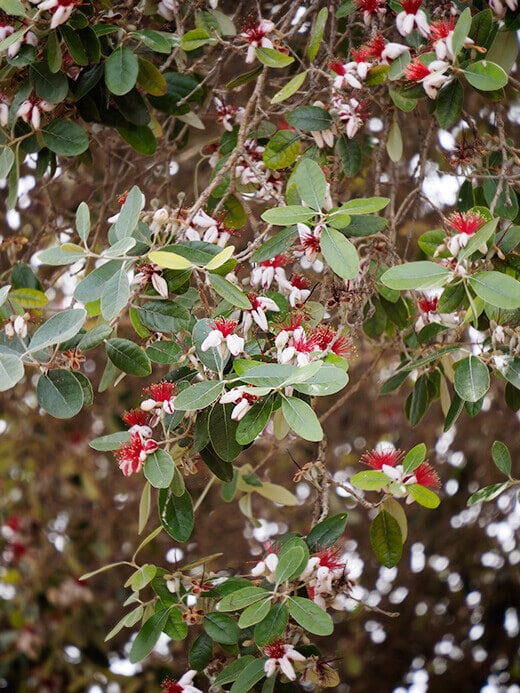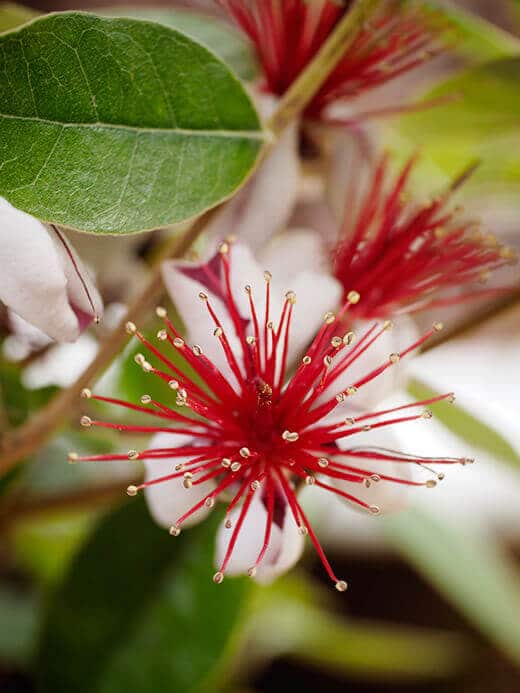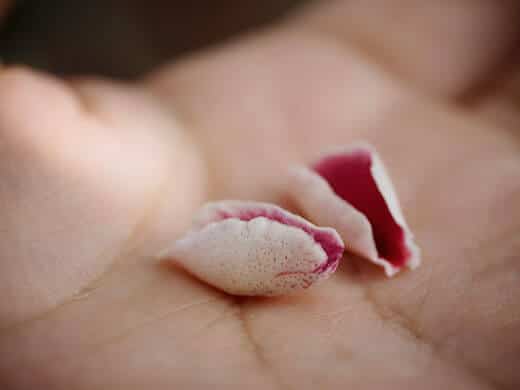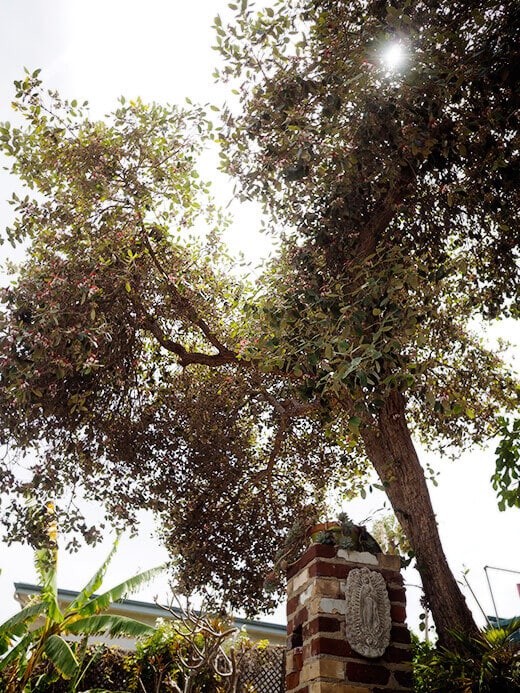I have a beautiful old feijoa tree in my yard, and every spring it attracts flocks of starlings that dance through its leaves. The starlings are hungry for the hundreds of candy red flowers that appear before the fruits set in late summer.
I liken these flowers to nature’s litter — swaying in the breeze, dropping from the tree, and covering the ground with soft, fragrant petals that brighten up the brown bark mulch.

Feijoa flowers are one of my favorite edible flowers. A lot of flowers are actually edible, but whether or not they’re palatable (on their own, not just as an accent) is a different story.
Feijoa flowers are unusual in that they’re succulent and sweet like marshmallows, with hints of the pineapple/kiwi/mint flavor inherent in feijoa fruits. I’ll often scatter a few flowers over a salad when I’m feeling fancy, or throw some to my chickens with the rest of their greens.

The flowers also feed the hummingbirds, butterflies, scrub jays, and squirrels that frequent the garden each day. With the onslaught of fruits that I get in the fall — thanks to prolific pollination by the birds and the bees — sometimes I wish they’d eat a little more!
The flowers have fleshy white petals with showy scarlet stamens; they remind me a bit of fuchsia flowers. Pulled apart, the petals look like sea shells with their lightly textured exterior and rosy red interior.


Botanically, feijoa (Acca sellowiana) is an evergreen shrub from the Myrtaceae family that can be espaliered or trained into a hedge, but mine has slowly grown into a large tree with a single trunk. It’s a few decades old and has grown to bear resemblance to an olive tree (very Mediterranean looking) with its gnarled trunk, silvery green leaves, and egg-shaped fruits.


It’s incredibly drought-tolerant as well, since the only water my feijoa receives is from natural rainfall… and we haven’t had too much of that lately. If you live in a warm climate (zones 8 and up) and want a low-maintenance fruit tree that’s also bird- and bee-friendly, a feijoa is a great pick!















Hello,
I have a 5 of these trees without issue until now. One is completely dead the other is on its way. Leaves are dropping, and the trunk seems very dry. At first I thought it was over watered but now I’m not sure.
The only changes we made are deep watering system,,weed screen and decorative rock on top of the screen. The two trees on the bottom section of our yard have brown curling leaves and are dropping almost all their leaves. The one that looks completely dead retained brain curled leaves but the truck and branches are dead.
The other tree appears to be dying too. I felt the soil and it’s wet after watering and dry several hours later. The tree receives the same amount of water since we planted it two years ago. Again the only change was a deep watering system as opposed to watering the top soil and we placed rock and weed screen. We live on Murrieta Ca. It’s very hot this time of the year. All five of our trees receive the same amount of water and were planted at the same time.
Please help me. We would love to save the tree especially since we already lost one.
Thank you,
Hi, do you know if the leaves can be ingested, or infused for a tea?
Unfortunately I don’t know the answer to this. I’ve only eaten the flowers and fruits.
i have a tree in my back yard i came here to find out what it was i saw a squirrel eating the flowers so i was curious.
That tree is very pretty, love the gnarly look. I find it fascinating that you can grow so many things outdoors, I’d love to live in a climate like yours. Someday, someday, until then I have to be contend with growing things inside since Swedish summers are all too short and winters too long and cold.
I’m very lucky to have a year-round garden outside, that’s for sure. 🙂
I have a feijoa bush about 4′ high and wide. It, too, produces abundant, delicious blooms and fruit, but the beauty of those flowers is amazing! I’m in Central FL and love getting ideas from your blog. Got some black raddish seeds to try because of your article on them. Thanks for sharing your delicious gardening life with us.
You’re welcome, and thanks for being here!
RT @FredJaicks: 🙂 MT @theGardenBetty: Beautiful blooms from drought-tolerant prolific fruit tree. Wins all around! http://t.co/lpF4gORsjk
Sweet and succulent, with hints of pineapple/kiwi/mint like the fruit. Edible Feijoa Flowers http://t.co/bx8bqaWN54 #gardenchat
Gorgeous to look at and delectable to eat, they bloom through the whole summer. Edible Feijoa Flowers http://t.co/egqGgfC06N #gardenchat
I LOVE how you’re always eating the most exciting things! This year, I’ve made a commitment to make syrup from prickly pear cactus fruit (tunas) instead of just munching them trail-side while backpacking.
Thanks for the inspiration!
PS: I’ve been enjoying your blog for YEARS but I don’t think I’ve ever commented. I’ll reach out more often.
Prickly pear syrup sounds delectable — it sounds like it would make a great glaze for a roast. Or a vinaigrette or a cocktail flavoring!
Thank you for reading, and I do hope you’ll comment more. I love to hear who else is out there. 🙂
🙂 MT @theGardenBetty: Beautiful blooms from a drought-tolerant & prolific fruit tree. Wins all around! http://t.co/xbIEaTCpVN #gardenchat
Beautiful blooms from a drought-tolerant and prolific fruit tree. Wins all around! Edible Feijoa Flowers http://t.co/ZtZ0apLVOB #gardenchat
Unlike most edible flowers, these ones are succulent and sweet like marshmallows. Edible Feijoa Flowers http://t.co/LqBIwhHkvj #gardenchat
Cool looking plant. Did you start it from seed?
No, my feijoa tree is 20-30 years old. You can usually find small shrubs in a nursery though, if you’re in a warm climate.
“The petals look like sea shells with their lightly textured exterior and rosy red interior.” http://t.co/8QEavX0jFz http://t.co/TLmuZiRd1U
They start appearing in spring before the onslaught of fruits in late summer. Edible Feijoa Flowers http://t.co/8ten0Vq71c #gardenchat
Blogged on Garden Betty: Edible Feijoa Flowers http://t.co/kwsLDITcnB